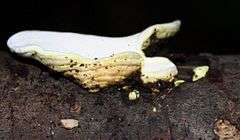Antrodiella citrea
| Antrodiella citrea | |
|---|---|
 | |
| Scientific classification | |
| Kingdom: | Fungi |
| Division: | Basidiomycota |
| Class: | Agaricomycetes |
| Order: | Polyporales |
| Family: | Steccherinaceae |
| Genus: | Antrodiella |
| Species: | A. citrea |
| Binomial name | |
| Antrodiella citrea (Berk.) Ryvarden (1984) | |
| Synonyms[1] | |
Antrodiella citrea is a bracket fungus native to Australia, and New Zealand.[5]
It was originally described as Polyporus citreus by English botanist Miles Joseph Berkeley in 1872,[6] and has undergone several name changes before being placed in the genus Antrodiella by Leif Ryvarden in 1984.[7]
Up to 2 cm (0.8 in) in diameter, the soft fruiting bodies are found on the underside of dead tree branches, particularly of Eucalyptus trees; they have the texture of chamois. The pored spore-bearing surface is white, while the upper surface is bright yellow. The spore print is white, and the smooth oval spores are around 2.5 by 4.5 μm.[8]
References
- ↑ "Antrodiella citrea (Berk.) Ryvarden 1984". MycoBank. International Mycological Association. Retrieved 2011-11-20.
- ↑ Cooke MC. (1886). "Praecursores ad Monographia Polypororum". Grevillea (in Latin). 14 (71): 77–87.
- ↑ Revis. gen. pl. (Leipzig) 3(2): 495 (1898)
- ↑ Cunningham GH. (1965). Polyporaceae of New Zealand. New Zealand Department of Scientific and Industrial Research, Bulletin 164. p. 137.
- ↑ Buchanan PK, Ryvarden L. (2000). "An annotated checklist of polypore and polypore-like fungi recorded from New Zealand". New Zealand Journal of Botany. 38 (2): 265–323. doi:10.1080/0028825x.2000.9512683.
- ↑ Berkeley MJ. (1872). "Australian fungi, received principally from Baron F. von Mueller and Dr. R. Schomburgk". Botanical Journal of the Linnean Society. 13 (67): 155–77. doi:10.1111/j.1095-8339.1872.tb02397a.x.
- ↑ Ryvarden L. (1984). "Type studies in the Polyporaceae 16. Species described by J.M. Berkeley, either alone or with other mycologists from 1856 to 1886". Mycotaxon. 20 (2): 329–63.
- ↑ Fuhrer B. (2005). A Field Guide to Australian Fungi. Melbourne: Bloomings Books. p. 247. ISBN 1-876473-51-7.
External links
This article is issued from Wikipedia - version of the 10/21/2016. The text is available under the Creative Commons Attribution/Share Alike but additional terms may apply for the media files.